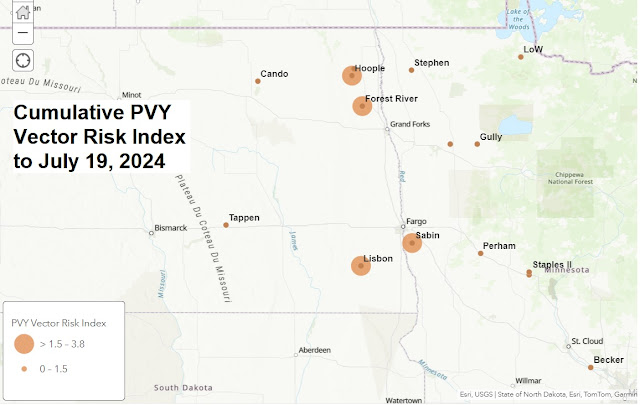Trap Catches July 18, 2025.
With 19 traps reporting this week the number of aphids recovered in traps this week increased ~20% this week, but the number of vector species was basically the same. The general pattern of population increase and PVY Vector Risk Index values are close to the rates seen in our 13 year average. Our vector species captures are slightly lower than the 13 year average, but our PVY Vector Risk Index values are roughly 3 times higher than our average numbers. Our trapping history suggests populations may increase at a steady rate for the next 4 weeks (see the graph on average regional weekly vector captures below). In any case, this would lead to high seasonal levels of PVY Vector Risk.
This week we saw an increase in aphid species hosted by small grains. Small grain crops are increasingly maturing and will have lowered nutritive value to aphids so winged forms are developing and moving to less mature crops to build new colonies. Our numbers of both corn leaf and English grain aphids more than doubled over last week. Buckthorn and Damson-hop aphids remain well represented in trap captures this week and cotton-melon and potato aphids were recovered at several locations. No green peach aphids were recovered this week.
Keep scouting and checking predictive sites.
The usual reminder:
- keep scouting; aphids can establish early after potatoes are up. Field scouting is less effective at finding aphid vector species that don't colonize potatoes. While these species will enter potato fields and probe plants, they can't survive on potatoes, consequently they'll keep moving through the field, sampling additional plants and spreading inoculum in the field. Remember to check predictive sites like this one and University of Wisconsin's weather based Vegetable Disease & Insect Forecasting site,(https://agweather.cals.wisc.edu/vdifn) which uses current weather data and historical populations as a predictor of current aphid vector populations. These will give you a better idea of the potential presence of non-colonizing aphids.
- the research literature reports that the use of crop oils is the most consistent post-planting technique in preventing transmission of PVY and it can be improved with the addition of the insecticide Lambda-Cyhalothrin.
- most of the research indicates that insecticides on their own are usually not effective enough at suppressing PVY transmission, but are still very useful parts of your management program. Treating fields with one of the anti-feeding insecticides (e.g. Sivanto Prime, Sefina, Transform, Fulfill or Beleaf) to control colonizing aphids, such as green peach, potato, or cotton melon aphids, can be beneficial in decreasing movement of PVY inoculum within fields
- aphids preferentially first colonize fields at the edge. Using border crops in the headlands may decrease aphid colonization. But if using a border crop, it's a good idea to use treated seed to prevent the development of potential vector species in that border. And to include those border crops when treating the field for colonizing aphids.
Happy scouting and have a great weekend!
This week we saw an increase in aphid species hosted by small grains. Small grain crops are increasingly maturing and will have lowered nutritive value to aphids so winged forms are developing and moving to less mature crops to build new colonies. Our numbers of both corn leaf and English grain aphids more than doubled over last week. Buckthorn and Damson-hop aphids remain well represented in trap captures this week and cotton-melon and potato aphids were recovered at several locations. No green peach aphids were recovered this week.
Keep scouting and checking predictive sites.
The usual reminder:
- keep scouting; aphids can establish early after potatoes are up. Field scouting is less effective at finding aphid vector species that don't colonize potatoes. While these species will enter potato fields and probe plants, they can't survive on potatoes, consequently they'll keep moving through the field, sampling additional plants and spreading inoculum in the field. Remember to check predictive sites like this one and University of Wisconsin's weather based Vegetable Disease & Insect Forecasting site,(https://agweather.cals.wisc.edu/vdifn) which uses current weather data and historical populations as a predictor of current aphid vector populations. These will give you a better idea of the potential presence of non-colonizing aphids.
- the research literature reports that the use of crop oils is the most consistent post-planting technique in preventing transmission of PVY and it can be improved with the addition of the insecticide Lambda-Cyhalothrin.
- most of the research indicates that insecticides on their own are usually not effective enough at suppressing PVY transmission, but are still very useful parts of your management program. Treating fields with one of the anti-feeding insecticides (e.g. Sivanto Prime, Sefina, Transform, Fulfill or Beleaf) to control colonizing aphids, such as green peach, potato, or cotton melon aphids, can be beneficial in decreasing movement of PVY inoculum within fields
- aphids preferentially first colonize fields at the edge. Using border crops in the headlands may decrease aphid colonization. But if using a border crop, it's a good idea to use treated seed to prevent the development of potential vector species in that border. And to include those border crops when treating the field for colonizing aphids.
Happy scouting and have a great weekend!
Click on any image below for full-scale version.
The average regional PVY Vector capture and PVY Vector Risk Index by week for 2025.
The regional average aphid vector captures/trap and PVY Vector Risk Index averaged from 2012 to 2023. The dates are expressed in ISO Week numbers (a standardized method of presenting dates across years).






No comments:
Post a Comment